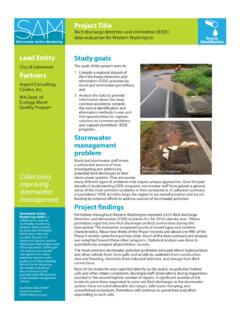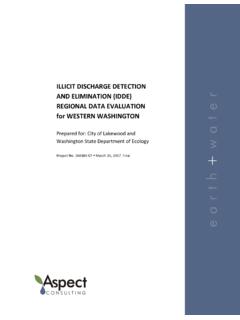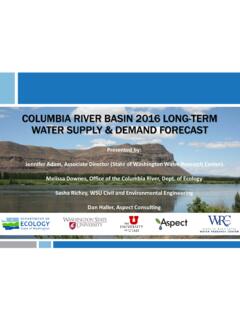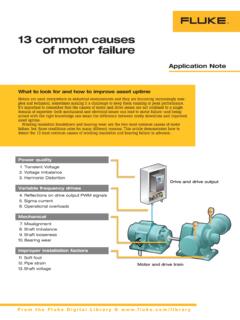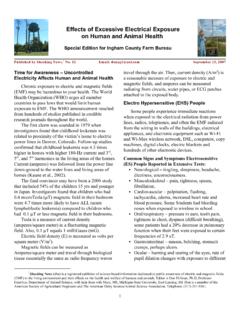Transcription of Impacts of excessive nutrients on seagrass and kelp
1 impact of excessive nutrients on seagrass and kelp Bart Christiaen, Helen Berry, Pete Dowty, Jeff Gaeckle, Lisa Ferrier The nearshore habitat DNR. Dowty 2011. Jonannessen & MacLennan 2007. Seagrasses in Washington State Native (Zostera marina). Non-native, dwarf or Japanese (Zostera japonica). DNR DNR. Eelgrass (Zostera) Surfgrass (Phyllospadix). Christiaen et al. 2016. Zostera marina is by far the most abundant seagrass in Puget Sound Phyllospadix mostly limited to outer coast, Strait and San Juan Islands DNR. DNR. DNR. PNNL DNR. Important habitat Aaron Baldwin DNR.
2 DNR DNR DNR Ron Thom Global declines in seagrass beds Accelerating loss of seagrass areal cover throughout the world Associated with increase in human population in coastal watersheds Waycott et al. 2009, PNAS 106(30). Eutrophication contributed to global loss Estuaries with high nitrogen loading have lost a high % of their seagrass beds If nitrogen load is reduced, seagrass beds can recover (Example: Tampa Bay). Valiela & Cole 2002, Ecosystems 5(1). Based on data from Southwest Florida Water Management District Competition for light DNR DNR. Phytoplankton blooms, nuisance algae or overgrowth by epiphytic algae Lower light availability Affects max depth of seagrass DNR beds DNR.
3 High sediment sulfide concentrations Drawing by Mark Fonseca Water oxic sulfate O2. Sediment anoxic sulfide Seagrasses tolerate moderate sediment sulfide concentrations High organic matter/ nutrients = high sulfide Frederiksen & Glud 2006, = seagrass loss Limnol. Oceanogr. 51(2). What about greater Puget Sound? Declines in eelgrass? Regional differences in depth limits of eelgrass beds in greater Puget Sound? Other signals of eutrophication in nearshore vegetation? DNR. Soundwide eelgrass area relatively stable Christiaen et al. 2016. On a soundwide scale: eelgrass area has been relatively stable since 2000 (DNR SVMP).
4 A study by NOAA found no major declines in eelgrass cover in herring spawn areas in Puget Sound over the last 40 years (Shelton et al. 2016). Local trends in eelgrass cover Increases/declines in eelgrass cover when looking on a smaller spatial scale Declines at the end of inlets & areas with longer residence times Associated with water quality? Christiaen et al. 2016. Regional pattern in max eelgrass depth Eelgrass grows to greater depths near the Strait and the San Juan Islands Eelgrass does not grow as deep in the southern and eastern parts of Puget Sound Possible causes: Sediment from rivers?
5 Gradient in tidal range? Regional differences in water quality? Christiaen et al. 2016. Presence of ulvoid algae High abundance of Ulva sp. is often associated with ecosystems that are enriched in nitrogen Central & South Puget Sound have a higher frequency of occurrence DNR. Nelson & Melton 2011. Case study: Quartermaster Harbor WDFW. 1980-1985. WDFW. 2005-2010. Esri Kelp in Washington State Tom Mumford Tom Mumford 625 species of seaweeds Kelp = brown algae from order USGS Laminariales 23 species of kelp = one of the most diverse kelp communities in the world!
6 Floating kelp Stalked kelp Prostrate kelp Mumford 2007. Floating Kelp Understory Kelp Floating kelp: 11% of shoreline Understory kelp: 31% of shoreline Ecological importance: primary productivity Tom Mumford Mumford 2007. Kelp and eelgrass fuel the detrital food web Export of particulate and dissolved organic matter DNR. Global declines in kelp beds Limited long-term datasets Small global average decline High degree of geographic variation in trends Krumhansl et al. 2016, PNAS 113(48). Kelp declines related to pollution Google Schiel & Foster 2015.
7 Best known research = interactions between grazers and kelp, climate and pollution are also important Most famous examples of sewage impact on kelp: Macrocystis beds near Palos Verdes and Point Loma Documented declines associated with pollution in Europe and Australia Low light, siltation & competition Deep edge of kelp beds can be limited by light Gametophyte life stage sensitive to siltation Competitive interactions with turf algae and Sargassum DNR. Floating kelp in greater Puget Sound Historical data from navigational maps, and kelp surveys for resource utilization and habitat management.
8 Earliest surveys go back to 1852 DNR. Floating kelp stable in the Strait Phister, Berry &. Mumford, in prep Floating kelp populations in the Strait of Juan de Fuca have not declined since 1911-1912! Some decline possible on east side. Large inter-annual variability, likely due to climatic factors Large declines around Bainbridge Island +27% -86% -54%. Berry et al. , in prep Floating kelp beds have almost completely disappeared from around Bainbridge Island Large losses in South Puget Sound Cumulative loss in floating kelp of more than 75%. since 1850/1950.
9 -27%. Candidate stressors: Increases in temperature Boat damage Competition with other algae Changes in water -65%. quality Berry et al. , in prep Case study: Squaxin Island DNR. DNR DNR. Conclusions Eelgrass and kelp are important components of nearshore habitats, both worldwide and in greater Puget Sound Global research indicate that eelgrass and kelp are vulnerable to excessive nutrient input through Reduction of water clarity Changes in sediment biogeochemistry / substrate Competitive interactions with other algae Local trends in eelgrass and kelp suggest that some locations in Puget Sound may be affected in similar way Protected embayments Areas with longer residence times.

